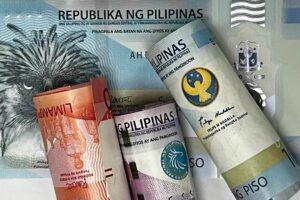




Philippines Trade Update: Trade trajectories trend along
 DOWNLOAD
DOWNLOAD

Policy Rate Updates: Double cut finale
 DOWNLOAD
DOWNLOAD

Monthly Economic Update: One for the road
 DOWNLOAD
DOWNLOAD


Peso climbs on dovish remarks from Fed chief

The peso rebounded against the dollar on Wednesday following dovish comments from US Federal Reserve Chair Jerome H. Powell.
The local unit closed at PHP 58.725 per dollar on Wednesday, strengthening by seven centavos from its PHP 58.795 finish on Tuesday, Bankers Association of the Philippines data showed.
The peso opened Wednesday’s session slightly stronger at PHP 58.77 per dollar. Its weakest showing was at PHP 58.83, while its intraday best was its close of PHP 58.725 versus the greenback.
Dollars exchanged decreased to USD 779.72 million on Wednesday from USD 915.14 million on Tuesday.
The peso went up against the dollar following dovish comments from Mr. Powell, a trader said in a phone interview.
The local unit rose as the Fed chief’s remarks renewed bets of more than one rate cut within the year, Rizal Commercial Banking Corp. Chief Economist Michael L. Ricafort said in a Viber message.
The US is back on a “disinflationary path,” Mr. Powell said on Tuesday, but policy makers need more data before cutting interest rates to verify that recent weaker inflation readings provide an accurate picture of the economy, Reuters reported.
Data for May showed the Fed’s preferred measure of inflation did not increase at all that month, while the 12-month rate of price increases has ebbed to 2.6%, still above the US central bank’s 2% target but on the way down after a scare in the first months of the year.
“We just want to understand that the levels that we’re seeing are a true reading on what is actually happening with underlying inflation,” Mr. Powell said at a monetary policy conference in Portugal sponsored by the European Central Bank.
“I think the last reading… and the one before it to a lesser suggest that we are getting back on the disinflationary path,” Mr. Powell said. “We want to be more confident that inflation is moving sustainably down toward 2%… before we start… loosening policy.”
US short-term interest rate futures were little changed on Tuesday, with prices continuing to imply that the Fed would deliver its first rate cut in September and a second one in December.
The Fed has kept its benchmark policy interest rate steady in the 5.25%-5.5% range since last July, and still described inflation as “elevated” in its June 12 policy statement.
Whether the Fed ends up cutting in September or winds up on a more delayed timetable will hinge on the coming employment and inflation reports, including the monthly jobs report on Friday and the July 11 release of the consumer price index for June.
The Fed will hold its next policy meeting on July 30-31.
While the timing of an initial rate cut may matter little to the larger economic outcomes the Fed is seeking, policy makers are sensitive to the signal they will send by cutting rates.
They want to be sure, in particular, that the first reduction in borrowing costs becomes the start of a full monetary easing cycle that brings rates steadily down to a level where the Fed feels it is neither encouraging nor discouraging businesses and households to invest and spend.
For many officials, that has been an argument in favor of being patient and waiting longer to make the first rate cut.
For the rest of the week, the market will look at economic reports out of the US, including latest jobs data, for leads, the trader said.
For Thursday, the trader expects the peso to move between PHP 58.50 and PHP 58.90 per dollar, while Mr. Ricafort sees it ranging from PHP 58.60 to PHP 58.80. — AMCS with Reuters
This article originally appeared on bworldonline.com





 By BusinessWorld
By BusinessWorld